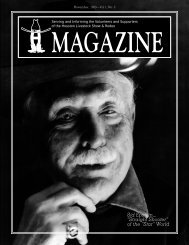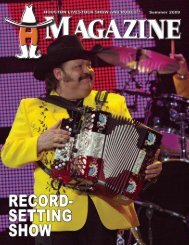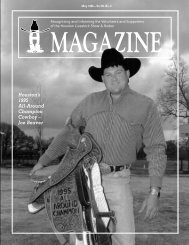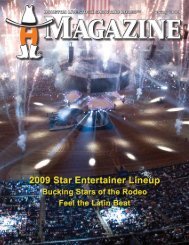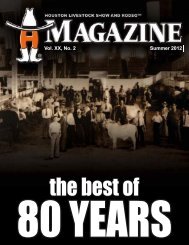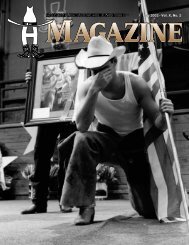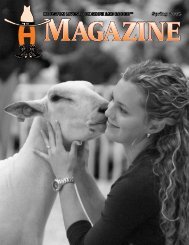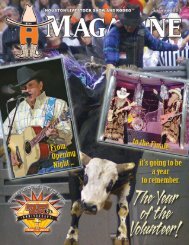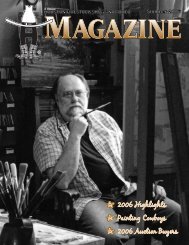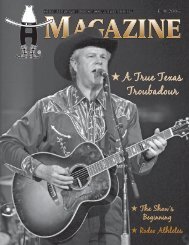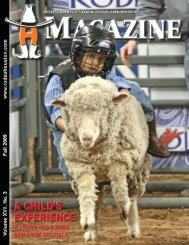magazine - Houston Livestock Show and Rodeo
magazine - Houston Livestock Show and Rodeo
magazine - Houston Livestock Show and Rodeo
Create successful ePaper yourself
Turn your PDF publications into a flip-book with our unique Google optimized e-Paper software.
The<br />
Devil’s<br />
Rope<br />
By Freeman Gregory<br />
There are two words that are very much a part of<br />
Texas. Although the proper spelling is “barbed wire,”<br />
they are pronounced “bobwahr” in many parts of the<br />
state. Barbed wire is as much a cultural icon in Texas as<br />
the Longhorn <strong>and</strong> the Lone Star. Thous<strong>and</strong>s of miles of<br />
barbed-wire fence stretch throughout the state, <strong>and</strong><br />
barbed wire plays an integral role in the state’s economy.<br />
Mankind has been building walls <strong>and</strong> fences of sorts for<br />
approximately 10,000 years. Anthropologists believe humans<br />
stopped being strictly hunter-gatherers <strong>and</strong> began to raise crops<br />
<strong>and</strong> animals around 8000 B.C., which created the need for<br />
fences. Local resources, such as timber, stone, mud <strong>and</strong> even<br />
hedges, were used to build barriers. Unfortunately, those who<br />
pushed U.S. boundaries west during the 19th century found<br />
wide-open expanses of prairie devoid of familiar building materials<br />
found in the heavily forested Northeast. Settlers did the<br />
best they could with what they could find, but they needed<br />
something better.<br />
The idea that metal wire strung between wooden posts<br />
made an effective fence had been around for a long time, but<br />
the quantity <strong>and</strong> poor quality of available metal made it infeasible.<br />
Wire had been available in small quantities since about<br />
A.D. 400, but the manufacturing process produced brittle wire<br />
that broke often.<br />
In 1856, English engineer Henry Bessemer accidentally discovered<br />
that adding forced air to molten iron superheated the<br />
liquefied metal, producing steel. Bessemer-style steel began<br />
U.S. production in 1867, <strong>and</strong>, by 1870, a Massachusetts company,<br />
Washburn & Moen Manufacturing, was producing large<br />
quantities of wire for distribution throughout the country.<br />
Plains farmers began to buy it to try as fencing material, but<br />
they were disappointed with the results. It seems cattle did not<br />
respect smooth wire.<br />
Then, Henry Rose, a farmer who lived near DeKalb, Ill., had<br />
an idea. Rose was having problems with a rambunctious cow.<br />
To discourage the animal from damaging his fence, he suspended<br />
a length of wood with barbs on it between two rows of<br />
smooth wire. It worked, <strong>and</strong> he decided to show off his ingenuity<br />
to friends at a county fair in 1873.<br />
4<br />
Three men who saw Rose’s device at the fair saw their future<br />
in it. Joseph Glidden, Jacob Haish <strong>and</strong> Isaac Ellwood all began<br />
to work on independent designs, but Haish reached the patent<br />
office first. It was Glidden, however, who came up with the best<br />
product. Dubbed “The Winner,” Glidden’s version involved<br />
barbs secured to smooth wire with a second wire <strong>and</strong> is the<br />
basis for the most popular design used today. He patented his<br />
wire in November 1874 <strong>and</strong> drew legal fire from Haish immediately.<br />
The court battle continued for the next 18 years. The<br />
U.S. Supreme Court eventually ruled in favor of Glidden.<br />
Ellwood approached Glidden with an offer to go into the<br />
barbed wire business together. Their Barb Fence Company<br />
soon became so successful that Washburn & Moen bought out<br />
Glidden for $60,000. Ellwood stayed with the business <strong>and</strong><br />
helped the company acquire <strong>and</strong> consolidate most of the existing<br />
570 patents, making Ellwood <strong>and</strong> Washburn & Moen the<br />
titans of barbed wire.<br />
In the 1870s, Texans had no interest in barbed wire. It was<br />
not a matter of indifference. It was unadulterated enmity. In<br />
Texas, there were no immense cattle ranches. Instead, Texas<br />
cattlemen practiced open-range operations by gathering herds<br />
of wild Longhorns <strong>and</strong> driving them north to market along<br />
fenceless public l<strong>and</strong>s. The last thing these “free-rangers” wanted<br />
was to allow farmers or settlers to lay claim to these public<br />
l<strong>and</strong>s. Barbed wire was an obvious advantage for farmers <strong>and</strong><br />
settlers alike.<br />
Still, business is business, <strong>and</strong> the Barb Fence Company saw<br />
market potential in Texas. In 1875, two of the company’s representatives,<br />
Henry Sanborn <strong>and</strong> J.P. Warner, spent time south of<br />
the Red River striving to convince cattlemen <strong>and</strong> farmers to try<br />
barbed wire. Neither group bought into it. Farmers thought it<br />
too flimsy, <strong>and</strong> cattlemen saw it almost as a religious abomination.<br />
Undiscouraged, Ellwood tried again. In late 1875, he sent<br />
21-year-old salesman John Warne “Bet-a-Million” Gates, who<br />
later founded The Texas Company (Texaco), to San Antonio to<br />
make a sale. Gates set up a corral of barbed wire in the city’s<br />
Military Plaza <strong>and</strong> filled it with “the wildest damn cattle in<br />
Texas.” It held, <strong>and</strong> the wire’s Texas sales jumped 1,200 percent<br />
over the next four years.



